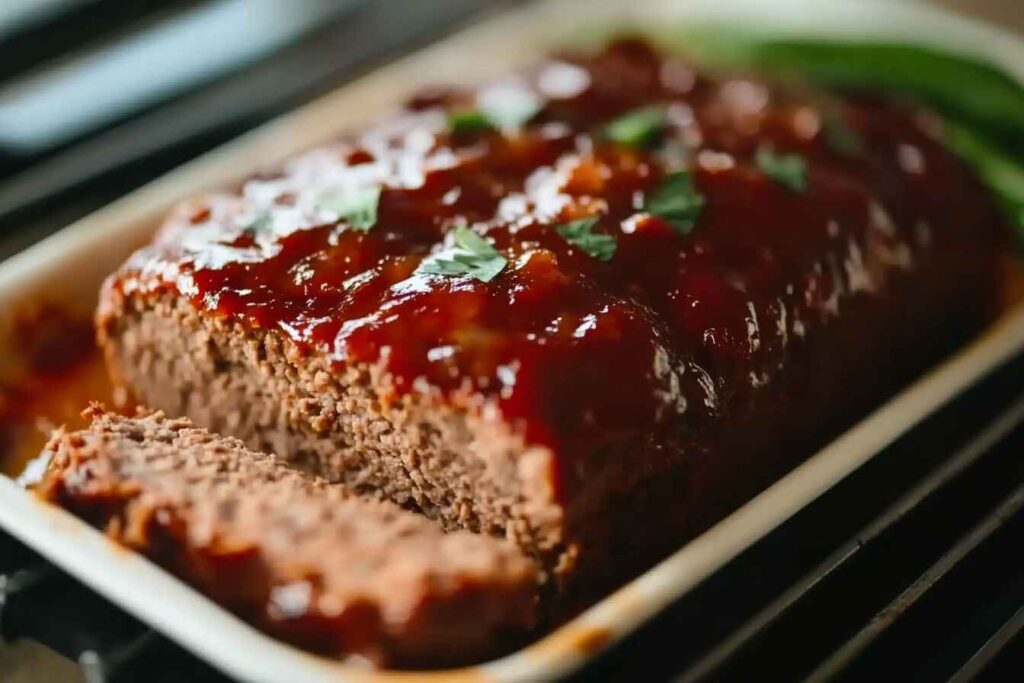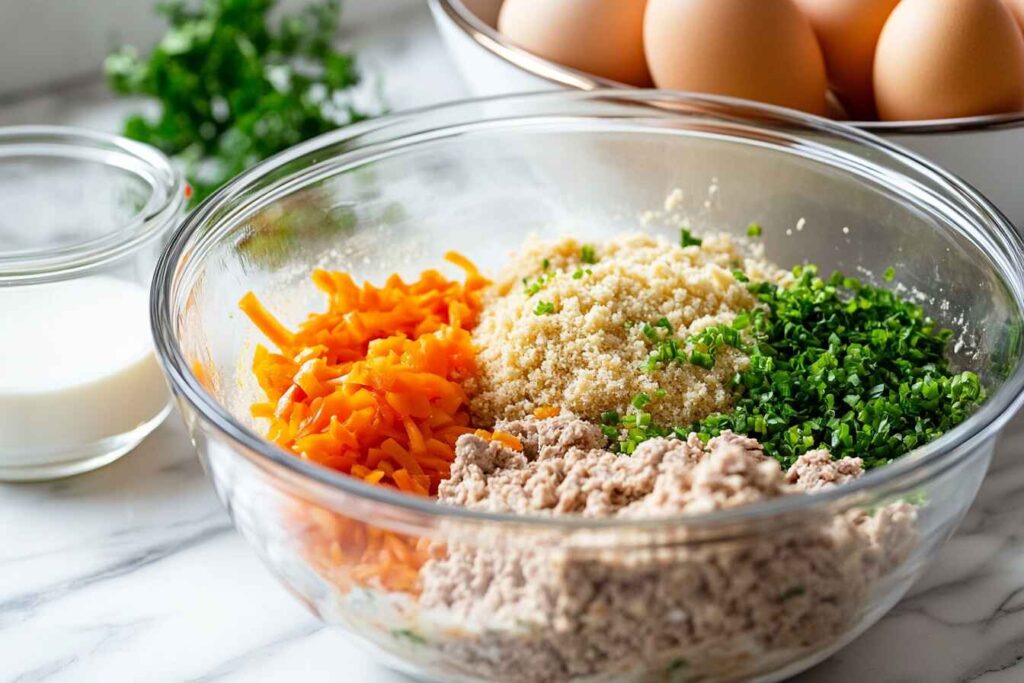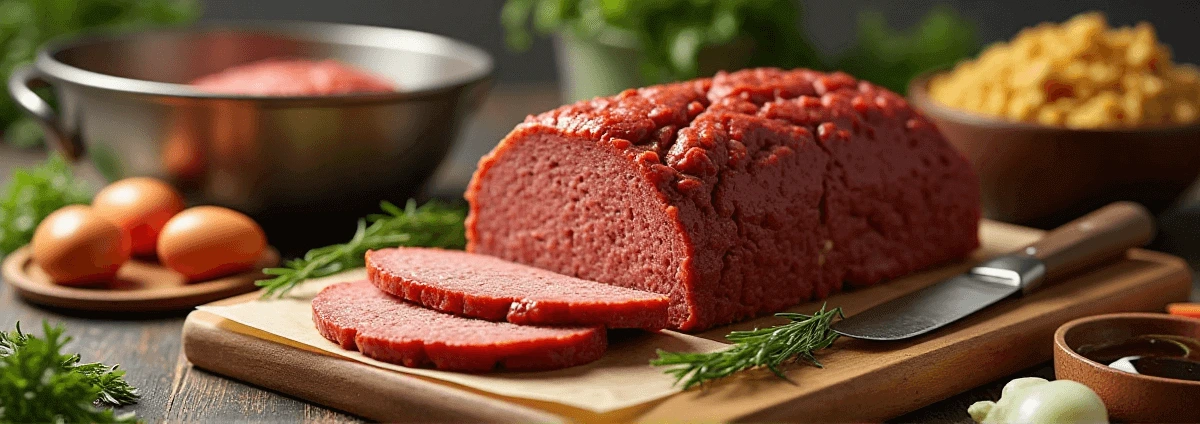Meatloaf is a beloved comfort food enjoyed by families across the globe, cherished for its hearty, savory flavor and incredible versatility. Yet, many cooks face the frustrating challenge of figuring out how to keep meatloaf from falling apart when it’s sliced or served. A well-structured meatloaf not only looks more appealing but also ensures every bite delivers the ideal combination of flavors and textures.
So, what’s the secret to creating a cohesive and intact meatloaf? The answer lies in the thoughtful selection and proper use of binding agents those essential ingredients that hold everything together and prevent the loaf from crumbling. From classic choices like eggs and breadcrumbs to creative alternatives for specific dietary needs, understanding how these ingredients work is key to perfecting your recipe.
Table of Contents
Common Problems with Meatloaf Structure
Making the perfect meatloaf means avoiding common mistakes that can affect its texture and stability. Below are the most frequent issues and practical solutions to ensure your meatloaf holds its shape and tastes delicious.Learn more about this approach in Use Stove Top Stuffing Instead of Breadcrumbs.
Why Binding Agents Are Essential in Meatloaf
Binding agents like eggs and breadcrumbs are crucial for holding meatloaf together. Without enough of these ingredients, the loaf can crumble and fall apart during cooking or slicing.
Tips for Using Binding Agents:
- Use 1 egg per pound of meat and 1/2 cup of breadcrumbs or an equivalent binder.
- This balance ensures the loaf holds its shape without sacrificing flavor or texture.
Avoiding Too Much Liquid in Meatloaf
Liquids like milk or broth are essential for keeping meatloaf moist, but adding too much can result in a soggy mixture that won’t set properly during baking. If you’re experimenting with alternative liquids, find helpful advice in Moist Meatloaf Secrets.
Solution:
- Add liquids gradually, mixing as you go to achieve a moist but firm consistency.
- Use measuring tools to avoid over-pouring and maintain the ideal texture.
Balancing the Meat-to-Binder Ratio
The ratio of meat to binders is critical for both texture and stability. An imbalance can lead to issues such as:
- Too much meat: Creates a dry, cracking loaf.
- Too many binders: Results in a soft, unstable texture.
Fix:
- Stick to the recommended ratio:
- 80/20 meat-to-fat ratio for moisture.
- 1/4 to 1/2 cup of binders per pound of meat for structure.
Preventing Overmixing in Meatloaf
Overmixing can break down the proteins in the meat, leading to a dense, rubbery texture that lacks tenderness.
Tips for Gentle Mixing:
- Mix binders and liquids together first to create a smooth base.
- Add the ground meat last, folding it in gently until just combined.
Signs of Overmixing:
- The mixture feels overly sticky or soft.
- The cooked loaf has a dense or rubbery texture.
Setting the Right Cooking Temperature
Baking your meatloaf at the wrong temperature can cause uneven cooking:
- High heat dries out the exterior and creates cracks.
- Low heat leaves the center undercooked and crumbly.
Recommendation:
- Bake meatloaf at 350°F (175°C) for even results.
- Use a thermometer to ensure the internal temperature reaches 160°F (71°C) before removing it from the oven.
Explore the pros and cons in Should I Cook My Meatloaf Covered or Uncovered?
Letting the Meatloaf Rest After Baking
Cutting into a meatloaf immediately after baking can release its juices, causing it to lose structure and fall apart.

Tip:
- Let the meatloaf rest for 10–15 minutes after removing it from the oven.
- This redistributes the juices and firms up the loaf, resulting in clean, stable slices.
Why Binding Agents Are the Foundation of Meatloaf
Binding agents are essential for creating a meatloaf that holds its shape and tastes great. Each type of binder has a specific role in enhancing the loaf’s texture, flavor, and moisture.
How Binding Agents Work
Binding agents perform several critical functions in meatloaf:
- Creating Structure: Eggs and breadcrumbs combine ingredients into a cohesive mixture.
- Locking in Moisture: Milk or oats prevent the loaf from drying out.
- Enhancing Flavor: Seasoned binders like cheese or spiced breadcrumbs boost the overall taste.
Common Binding Agents for Meatloaf
Different binding agents offer various benefits:
- Eggs: Rich in protein, eggs solidify during cooking to hold the meatloaf together.
- Breadcrumbs: Absorb moisture and add structure.
- Oats: A gluten-free option that soaks up liquids and adds a slight nuttiness.
- Cheese: Melts into the meatloaf, providing both flavor and support.
- Flaxseeds or Chia Seeds: Mixed with water, these are great alternatives for vegetarian or egg-free recipes.
Striking the Perfect Balance of Ingredients
Finding the right balance of binders and meat ensures a loaf that’s firm but not dry.
Recommended Ratio:
- For every pound of ground meat, use:
- 1 egg
- 1/4 to 1/2 cup of breadcrumbs or a similar binder.
Adjustments for Add-Ins:
- Reduce liquids if adding high-moisture ingredients like onions or tomatoes.
- Increase binders slightly for recipes with extra vegetables to maintain stability.
Key Ingredients for a Stable Meatloaf
Each ingredient in your recipe adds to the stability and flavor of the meatloaf.
Examples of Essential Ingredients:
- Eggs and Breadcrumbs: Provide structure and absorb moisture.
- Milk or Cream: Hydrate the mixture for a tender texture.
- Vegetables: Add flavor but should be sautéed to reduce excess water.
- Cheese: Acts as a secondary binder while adding creaminess.
By combining the right ingredients and following these tips, you can make a meatloaf that’s flavorful, firm, and perfect for slicing and serving.
Essential Binding Agents and Tips for a Perfect Meatloaf
Making a meatloaf that holds its shape starts with choosing the right binding agents and using effective preparation techniques. These steps are key to keeping your meatloaf moist, flavorful, and firm. Below, you’ll find a complete guide to the best binding agents and practical tips for success.
Binding Agents That Keep Meatloaf Together
Binding agents are the glue that keeps your meatloaf intact. Each one plays a unique role in improving the loaf’s shape, taste, and texture. Let’s look at the best options and how to use them.
Eggs: The Essential Binder
Eggs are a key ingredient in almost every meatloaf recipe. Their proteins create a strong but flexible structure, holding the loaf together.
How to Use Eggs:
- Use 1 large egg per pound of ground meat for the best results.
- Whisk eggs before adding them to ensure they spread evenly.
Tips for Using Eggs:
- For richer flavor, use only the yolks, but note that this may slightly change the texture.
- For egg-free recipes, substitute with flaxseeds or chia seeds mixed with water (1 tablespoon seed + 2.5 tablespoons water per egg).
Breadcrumbs: A Classic Choice
Breadcrumbs absorb moisture and expand as the meatloaf cooks, resulting in a texture that’s soft but sturdy.
Types of Breadcrumbs
- Regular breadcrumbs: A standard choice for most recipes.
- Panko breadcrumbs: Provide a lighter, fluffier texture.
- Gluten-free breadcrumbs: Ideal for those with dietary restrictions.
How to Use Breadcrumbs
- Add 1/4 to 1/2 cup per pound of ground meat, depending on the desired firmness.
- Soak breadcrumbs in milk or broth before adding them to the meat for a smoother texture.
Oats: A Gluten-Free Alternative
Rolled oats are a great option for those who need a gluten-free binder. They soak up liquids and add structure to the mixture.
How to Use Oats
- Use 1/4 to 1/3 cup per pound of meat.
- For a smoother texture, pulse oats in a food processor before mixing.
Tip: Oats add a mild nutty flavor that pairs well with spices like garlic, onion, and paprika.
Flour or Cornstarch for Vegetable-Heavy Recipes
If your recipe includes lots of vegetables or extra liquid, flour or cornstarch can help thicken the mixture and keep the loaf stable.
How to Use Flour or Cornstarch:
- Add 1–2 tablespoons per loaf.
- Mix thoroughly to avoid lumps.
Cheese: Flavor and Stability
Cheese does double duty by acting as a binder and adding creaminess to the meatloaf. As it melts, it helps hold everything together.
Best Cheeses for Meatloaf:
- Shredded mozzarella, cheddar, or Parmesan for bold flavors.
- Cream cheese for a softer, richer texture.
How to Use Cheese:
- Mix 1/4 to 1/2 cup of shredded cheese into the meatloaf mixture to enhance both taste and stability.
Liquids: Keeping Meatloaf Moist
Liquids like milk, cream, or broth hydrate dry binders like breadcrumbs or oats, ensuring your meatloaf stays juicy and tender.
How to Use Liquids:
- Combine 1/4 to 1/2 cup of liquid with your chosen binder before mixing.
- Adjust based on the moisture content of other ingredients.
Tip: Avoid adding too much liquid, as this can make the loaf overly soft and prone to breaking apart.
Techniques for Mixing Meatloaf Ingredients
Combining your ingredients the right way is essential for a meatloaf that’s both flavorful and stable. Proper mixing, avoiding overhandling, and maintaining correct ratios are all key.

Mixing Ingredients Evenly
Achieving a uniform distribution of binders, seasonings, and vegetables helps prevent weak spots that crumble during cooking.
Steps for Even Mixing:
- Start with Dry Ingredients: Mix binders like breadcrumbs, oats, or flour with seasonings (e.g., salt, pepper, garlic powder).
- Whisk the Wet Ingredients: Combine eggs, milk, or broth in a separate bowl before adding to the dry mixture.
- Use Your Hands: Gently mix everything together using your hands to avoid overworking the meat.
Avoiding Overmixing
Overmixing breaks down the proteins in the meat, leading to a dense, rubbery texture.
Tips to Prevent Overmixing:
- Mix binders and liquids first to create a smooth base.
- Add ground meat last, folding it in gently.
- Stop mixing as soon as the ingredients are evenly combined.
Signs of Overmixing:
- The mixture feels sticky or overly soft.
- The cooked loaf has a rubbery, compact texture.
Using the Right Binder-to-Meat Ratio
A balanced ratio of binders to meat ensures the loaf is firm enough to hold together yet tender enough to slice easily.
Recommended Ratios:
For every pound of ground meat, use:
- 1 large egg
- 1/4 to 1/2 cup of breadcrumbs or oats
- 1/4 cup of liquid (milk, broth, etc.)
Adjustments for Add-Ins:
- Reduce liquids if adding high-moisture ingredients like onions or tomatoes.
- Add more binder if the recipe includes extra vegetables.
Shaping and Glazing for a Stable Meatloaf
How you shape and glaze your meatloaf affects both its stability and presentation.
Tips for Shaping Meatloaf
- Avoid Overpacking: Pressing the mixture too tightly can create a dense loaf that’s prone to cracking.
- Shape Evenly: A uniform thickness ensures the loaf cooks evenly without any areas drying out.
Adding a Glaze Without Weakening the Loaf
A glaze enhances flavor and appearance but must be applied carefully to avoid structural issues.
Tips for Applying a Glaze:
- Apply a thin layer of glaze (e.g., ketchup or BBQ sauce) after the loaf has baked for 15 minutes. This allows the meatloaf to set before adding moisture.
- Avoid using heavy sauces that can seep into the meat and weaken its cohesion.
FAQs: Keeping Meatloaf from Falling Apart
Why is my meatloaf always dry?
- Answer: Overcooking or using lean meats without enough fat can lead to dryness. Try using a blend of ground beef with some fat, like 80/20, and avoid overbaking.
How many eggs should I use in meatloaf?
- Answer: Use 1 egg per pound of ground meat as a general guideline for proper binding.
Can I skip breadcrumbs in meatloaf?
- Answer: Yes, but substitute with another binder like oats, crushed crackers, or almond flour to maintain cohesion.
How do I keep my meatloaf moist?
- Answer: Incorporate ingredients like milk, broth, or grated vegetables to add moisture and bake at a moderate temperature.
What temperature should I bake meatloaf?
- Answer: Bake at 350°F (175°C) until the internal temperature reaches 160°F (70°C) for a perfectly cooked loaf.
Can I prepare meatloaf in advance?
- Answer: Yes, you can assemble the meatloaf and store it in the refrigerator for up to 24 hours before baking.
Conclusion: Mastering Meatloaf That Stays Intact
Perfecting meatloaf is all about understanding how to use binding agents effectively, balancing the ingredients properly, and following the right steps carefully. Additionally, by avoiding common mistakes and addressing problems as they arise, you can create a meatloaf that is not only tasty but also visually appealing and holds together beautifully. With these simple yet effective tips, you’ll be ready to prepare a great meatloaf that will wow everyone at your next dinner. So, go ahead and give it a try enjoy your cooking experience and the delicious results!

